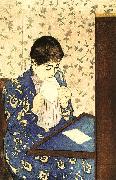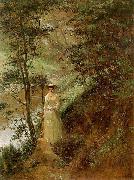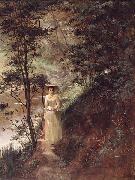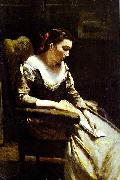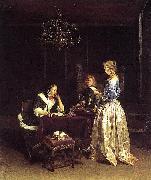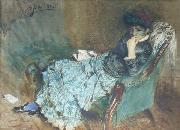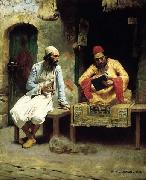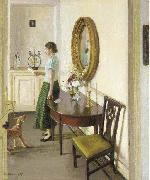Wholesale Oil Painting Reproductions No Minimum and Door to Door! |
|||||||||||
|
|
|||||||||||

|
|||||||||||
|
|
|
||||||||
All Mary Cassatt Oil Paintings |
||||||||
|
|
||||||||
|
|
||||||||
|
Artist Introduction: 1844-1926
Mary Cassatt Galleries
Within months of her return to Europe in the autumn of 1871, Cassatt??s prospects had brightened. Her painting Two Women Throwing Flowers During Carnival was well received in the Salon of 1872, and was purchased. She attracted much favorable notice in Parma and was supported and encouraged by the art community there: ??All Parma is talking of Miss Cassatt and her picture, and everyone is anxious to know her??.
After completing her commission for the archbishop, Cassatt traveled to Madrid and Seville, where she painted a group of paintings of Spanish subjects, including Spanish Dancer Wearing a Lace Mantilla (1873, in the National Museum of American Art, Smithsonian Institution). In 1874, she made the decision to take up residence in France. She was joined by her sister Lydia who shared an apartment with her. Cassatt continued to express criticism of the politics of the Salon and the conventional taste that prevailed there. She was blunt in her comments, as reported by Sartain, who wrote: ??she is entirely too slashing, snubs all modern art, disdains the Salon pictures of Cabanel, Bonnat, all the names we are used to revere??. Cassatt saw that works by female artists were often dismissed with contempt unless the artist had a friend or protector on the jury, and she would not flirt with jurors to curry favor. Her cynicism grew when one of the two pictures she submitted in 1875 was refused by the jury, only to be accepted the following year after she darkened the background. She had quarrels with Sartain, who thought Cassatt too outspoken and self-centered, and eventually they parted. Out of her distress and self-criticism, Cassatt decided that she needed to move away from genre paintings and onto more fashionable subjects, in order to attract portrait commissions from American socialites abroad, but that attempt bore little fruit at first.
In 1877, both her entries were rejected, and for the first time in seven years she had no works in the Salon. At this low point in her career she was invited by Edgar Degas to show her works with the Impressionists, a group that had begun their own series of independent exhibitions in 1874 with much attendant notoriety. The Impressionists (also known as the ??Independents?? or ??Intransigents??) had no formal manifesto and varied considerably in subject matter and technique. They tended to prefer open air painting and the application of vibrant color in separate strokes with little pre-mixing, which allows the eye to merge the results in an ??impressionistic?? manner. The Impressionists had been receiving the wrath of the critics for several years. Henry Bacon, a friend of the Cassatts, thought that the Impressionists were so radical that they were ??afflicted with some hitherto unknown disease of the eye??. They already had one female member, artist Berthe Morisot, who became Cassatt??s friend and colleague.
Degas, Portrait of Miss Cassatt, Seated, Holding Cards, c. 1876-1878, oil on canvasCassatt admired Degas, whose pastels had made a powerful impression on her when she encountered them in an art dealer's window in 1875. "I used to go and flatten my nose against that window and absorb all I could of his art," she later recalled. "It changed my life. I saw art then as I wanted to see it." She accepted Degas' invitation with enthusiasm, and began preparing paintings for the next Impressionist show, planned for 1878, which (after a postponement because of the World??s Fair) took place on April 10, 1879. She felt comfortable with the Impressionists and joined their cause enthusiastically, declaring: ??we are carrying on a despairing fight & need all our forces??. Unable to attend cafes with them without attracting unfavorable attention, she met with them privately and at exhibitions. She now hoped for commercial success selling paintings to the sophisticated Parisians who preferred the avant-garde. Her style had gained a new spontaneity during the intervening two years. Previously a studio-bound artist, she had adopted the practice of carrying a sketchbook with her while out-of-doors or at the theater, and recording the scenes she saw.
Summertime, c. 1894, oil on canvasIn 1877, Cassatt was joined in Paris by her father and mother, who returned with her sister Lydia. Mary valued their companionship, as neither she nor Lydia had married. Mary had decided early in life that marriage would be incompatible with her career. Lydia, who was frequently painted by her sister, suffered from recurrent bouts of illness, and her death in 1882 left Cassatt temporarily unable to work.
Cassatt??s father insisted that her studio and supplies be covered by her sales, which were still meager. Afraid of having to paint ??potboilers?? to make ends meet, Cassatt applied herself to produce some quality paintings for the next Impressionist exhibition. Three of her most accomplished works from 1878 were Portrait of the Artist (self-portrait), Little Girl in a Blue Armchair, and Reading Le Figaro (portrait of her mother).
Degas had considerable influence on Cassatt. She became extremely proficient in the use of pastels, eventually creating many of her most important works in this medium. Degas also introduced her to etching, of which he was a recognized master. The two worked side-by-side for awhile, and her draftsmanship gained considerable strength under his tutelage. He depicted her in a series of etchings recording their trips to the Louvre. She had strong feelings for him but learned not to expect too much from his fickle and temperamental nature. The sophisticated and well-dressed Degas, then forty-five, was a welcome dinner guest at the Cassatt residence.
The Impressionist exhibit of 1879 was the most successful to date, despite the absence of Renoir, Sisley, Manet and C??zanne, who were attempting once again to gain recognition at the Salon. Through the efforts of Gustave Caillebotte, who organized and underwrote the show, the group made a profit and sold many works, although the criticism continued as harsh as ever. The Revue des Deux Mondes wrote, ??M. Degas and Mlle. Cassatt are, nevertheless, the only artists who distinguish themselves??and who offer some attraction and some excuse in the pretentious show of window dressing and infantile daubing??.
Cassatt displayed eleven works, including La Loge. Although critics claimed that Cassatt??s colors were too bright and that her portraits were too accurate to be flattering to the subjects, her work was not savaged as was Monet's, whose circumstances were the most desperate of all the Impressionists at that time. She used her share of the profits to purchase a work by Degas and one by Monet. She exhibited in the Impressionist Exhibitions that followed in 1880 and 1881, and she remained an active member of the Impressionist circle until 1886. In 1886, Cassatt provided two paintings for the first Impressionist exhibition in the United States, organized by art dealer Paul Durand-Ruel. Her friend Louisine Elder married Harry Havemeyer in 1883, and with Cassatt as advisor, the couple began collecting the Impressionists on a grand scale. Much of their vast collection is now in the Metropolitan Museum of Art in New York City. She also made several portraits of family members during that period, of which Portrait of Alexander Cassatt and His Son Robert Kelso (1885) is one of her best regarded. Cassatt??s style then evolved, and she moved away from Impressionism to a simpler, more straightforward approach. She began to exhibit her works in New York galleries as well. After 1886, Cassatt no longer identified herself with any art movement and experimented with a variety of techniques.
|
||||||||
|
|
||||||||
|
The Letter Painting ID:: 3154 |
1890-91 |
|||||||
Height Width |
INS/CM Quality |
|||||||
|
X |
| |||||||
|
|
||||||||
All Frederick Mccubbin Oil Paintings |
||||||||
|
|
||||||||
|
|
||||||||
|
Artist Introduction: Australian Painter, 1855-1917
By the early 1880s, his work began to attract considerable attention and won a number of prizes from the National Gallery, including a 30-pound first prize in 1883 in their annual student exhibition, and by the mid-1880s began to concentrate more on the works of the Australian bush which made him most famous. In 1883, he received first prize in the first annual Gallery students' exhibition, for best studies in colour and drawing. In 1888, he became instructor and master of the School of Design at the National Gallery. In this position he taught a number of students who themselves became prominent Australian artists, including Charles Conder and Arthur Streeton. He continued to paint through the first two decades of the 20th century, though by the beginning of World War I his health began to fail. He travelled to England in 1907 and visited Tasmania, but aside from these relatively short excursions lived most of his life in Melbourne. McCubbin married Annie Moriarty in March, 1889. They had seven children, of whom their son Louis also became an artist. In 1901 McCubbin and his family moved to Mount Macedon, where he was inspired by the surrounding bush and has experimented with the light and its effects on colour in nature. In 1912, |
||||||||
|
|
||||||||
|
|
The Letter Painting ID:: 59869 |
The Letter 1884 |
||||||
Height Width |
INS/CM Quality |
|||||||
|
X |
| |||||||
|
|
||||||||
All Frederick Mccubbin Oil Paintings |
||||||||
|
|
||||||||
|
|
||||||||
|
Artist Introduction: Australian Painter, 1855-1917
By the early 1880s, his work began to attract considerable attention and won a number of prizes from the National Gallery, including a 30-pound first prize in 1883 in their annual student exhibition, and by the mid-1880s began to concentrate more on the works of the Australian bush which made him most famous. In 1883, he received first prize in the first annual Gallery students' exhibition, for best studies in colour and drawing. In 1888, he became instructor and master of the School of Design at the National Gallery. In this position he taught a number of students who themselves became prominent Australian artists, including Charles Conder and Arthur Streeton. He continued to paint through the first two decades of the 20th century, though by the beginning of World War I his health began to fail. He travelled to England in 1907 and visited Tasmania, but aside from these relatively short excursions lived most of his life in Melbourne. McCubbin married Annie Moriarty in March, 1889. They had seven children, of whom their son Louis also became an artist. In 1901 McCubbin and his family moved to Mount Macedon, where he was inspired by the surrounding bush and has experimented with the light and its effects on colour in nature. In 1912, |
||||||||
|
|
||||||||
|
|
The Letter Painting ID:: 80509 |
oil on canvas
Date 1884
cyf |
||||||
Height Width |
INS/CM Quality |
|||||||
|
X |
| |||||||
|
|
||||||||
All Jean-Baptiste Camille Corot Oil Paintings |
||||||||
|
|
||||||||
|
|
||||||||
|
Artist Introduction: (July 17, 1796 - February 22, 1875) was a French landscape painter and printmaker in etching. Corot was the leading painter of the Barbizon school of France in the mid-nineteenth century. He is a pivotal figure in landscape painting and his vast output simultaneously references the Neo-Classical tradition and anticipates the plein-air innovations of Impressionism. |
||||||||
|
|
||||||||
|
|
The Letter Painting ID:: 90444 |
1865-70
Medium Oil on wood
Dimensions 54 x 36 cm (21.3 x 14.2 in)
cyf |
||||||
Height Width |
INS/CM Quality |
|||||||
|
X |
| |||||||
|
|
||||||||
All Adriaan de Lelie Oil Paintings |
||||||||
|
|
||||||||
|
|
||||||||
|
Artist Introduction: was born at Tilburg in 1755, and was a scholar of Peeters, a painter of tapestries and ornaments, and afterwards of Quertenmont at Antwerp. He made copies of many of the portraits by Rubens and Van Dyck at Desseldorf, and also of historical pictures by Italian and Dutch masters. By the advice of Professor Camper, he established himself at Amsterdam, where he painted a great number of portraits and cabinet pictures; among the latter is one of the celebrated amateur Jan Gildemeester showing his collection to a party of ladies and gentlemen, in which the principal pictures are readily recognised. One of his best works is that representing the 'Drawing Academy' of the Felix Meritis Society at Amsterdam. His pictures are highly esteemed in Holland and Germany, where they are to be met with in the best collections. He died at Amsterdam in 1820.
|
||||||||
|
|
||||||||
|
|
The Letter Painting ID:: 93643 |
Date circa 1660-1662
Medium oil on canvas
Dimensions 79 x 68 cm (31.1 x 26.8 in)
TTD |
||||||
Height Width |
INS/CM Quality |
|||||||
|
X |
| |||||||
|
|
||||||||
All Anders Zorn Oil Paintings |
||||||||
|
|
||||||||
|
|
||||||||
|
Artist Introduction: Swedish 1860-1920
Swedish painter, etcher and sculptor. He was brought up by his grandparents at Mora. As he displayed a precocious talent for drawing he was admitted to the preparatory class of the Kungliga Akademi for de Fria Konsterna, Stockholm, at the age of 15. Dissatisfied with the outdated teaching and discipline of the Academy and encouraged by his early success as a painter of watercolour portraits and genre scenes (e.g. Old Woman from Mora, 1879; Mora, Zornmus.) Zorn left the Academy in 1881 to try to establish an international career. He later resided mainly in London but also travelled extensively in Italy, France, Spain, Algeria and the Balkans and visited Constantinople. However, he continued to spend most of his summers in Sweden. |
||||||||
|
|
||||||||
|
|
The Letter Painting ID:: 95399 |
Country of Origin: Sweden
Tagged With: Paintings
TTD |
||||||
Height Width |
INS/CM Quality |
|||||||
|
X |
| |||||||
|
|
||||||||
All Charles Sprague Pearce Oil Paintings |
||||||||
|
|
||||||||
|
|
||||||||
|
Artist Introduction: For other people named Charles Pearce, see Charles Pearce (disambiguation).
Charles Sprague Pearce (October 13, 1851 - May 18, 1914) was an American artist.
|
||||||||
|
|
||||||||
|
|
The letter Painting ID:: 95400 |
Date 1875(1875)
Medium oil on canvas
Dimensions 56 x 45.8 cm (22 x 18 in)
TTD |
||||||
Height Width |
INS/CM Quality |
|||||||
|
X |
| |||||||
|
|
||||||||
All Harold Herbert Oil Paintings |
||||||||
|
|
||||||||
|
|
||||||||
|
Artist Introduction: Australian, 1892-1945 |
||||||||
|
|
||||||||
|
|
The Letter Painting ID:: 97377 |
Oil on canvas, 61 x 50.8 cm
Date 1937(1937)
cyf |
||||||
Height Width |
INS/CM Quality |
|||||||
|
X |
| |||||||
|
|
||||||||
|
Prev Next
|
||||||||
|
|
||||||||
|
Related Paintings to Harold Herbert :. |
||||||||
|
|
||||||||
|
CONTACT US |
